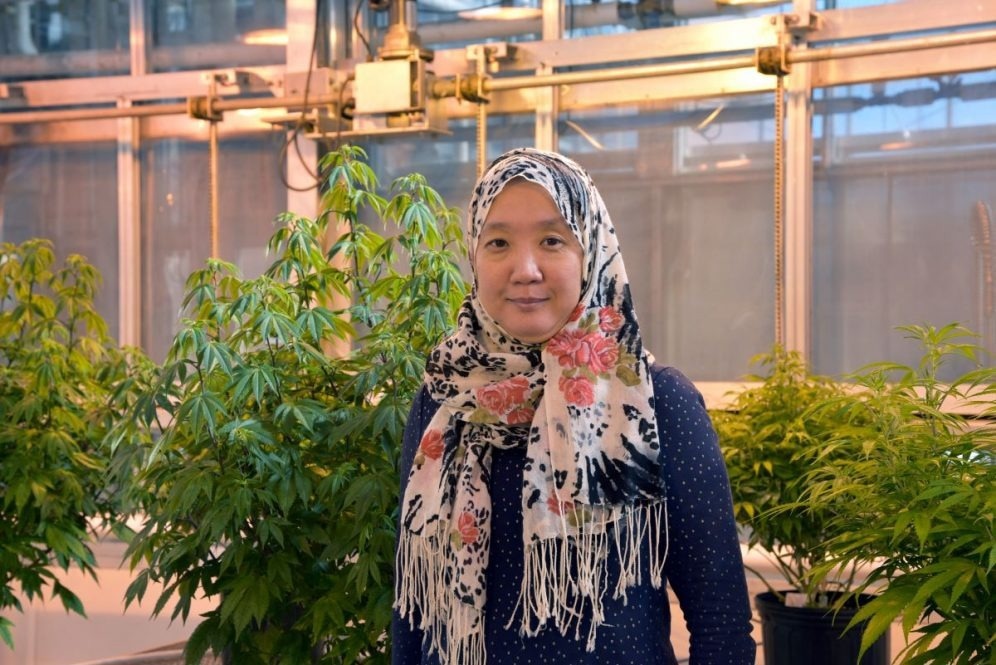Many compounds known as cannabinoids are found in cannabis, a plant that is receiving more and more attention for its extensive medical potential.
 Yi Ma near cannabis plants in the CAHNR Greenhouse. Image Credit: Jason Sheldon/UConn Photo.
Yi Ma near cannabis plants in the CAHNR Greenhouse. Image Credit: Jason Sheldon/UConn Photo.
Cannabidiolic acid (CBD), one of the most well-known cannabinoids, is used to treat a variety of conditions including pain, nausea, and inflammation.
Trichomes, little spikey protrusions on the surface of cannabis flowers, create cannabinoids. Beyond this fact, nothing is known about the mechanisms that regulate cannabinoid production.
The National Research Initiative of the US Department of Agriculture provided funding to Yi Ma, a research assistant professor, and Gerry Berkowitz, a professor in the College of Agriculture, Health and Natural Resources, to study the molecular mechanisms underlying trichrome development and cannabinoid synthesis.
The transcription factors that are responsible for trichome initiation and cannabis biosynthesis were found by Berkowitz and Ma, together with previous graduate students Samuel Haiden and Peter Apicella. An organism’s DNA can only be expressed if it is translated into RNA by molecules known as transcription factors.
In this instance, epidermal cells of the flowers change into trichomes as a result of the transcription factors. A feature piece about the team’s findings was just released in Plants. Research on trichomes in a related field was also published in Plant Direct. UConn has submitted a provisional patent application for the technique because of the gene’s potential economic significance.
With the help of this new grant, the researchers will keep looking at how these transcription factors affect the growth of trichomes as flowers mature.
The promoters—the region of the DNA that transcription factors attach to—will be cloned by Berkowitz and Ma. They will next insert the promoters and a copy of the firefly luciferase gene into the cells of a model plant. The luciferase is fused to the cannabis promoter so that if the promoter is triggered by a signal, the luciferase reporter will produce light.
It’s a nifty way to evaluate signals that orchestrate cannabinoid synthesis and trichome development.”
Gerry Berkowitz, Professor, College of Agriculture, Health and Natural Resources, University of Connecticut
The cloned promoters and luciferase will be added to a plasmid by the researchers. Circular DNA molecules known as plasmids are capable of independent replication from chromosomes. Because they are not a part of the plant’s genomic DNA, this enables the researchers to express the desired genes. These plasmids will be introduced into plant leaves or protoplasts, which are plant cells without a cell wall.
The luciferase “reporter” will emit light when the promoter directing luciferase expression interacts with the transcription factors involved in trichome growth (or when activated by other signals like plant hormones). A luminometer, which gauges how much light is emitted by the sample, will be used by Ma and Berkowitz.
This will reveal to the researchers if the promoter areas they are examining are governed by transcription factors that stimulate trichome formation or regulate the expression of genes that encode cannabis biosynthesis enzymes. Additionally, researchers can discover whether the promoters react to hormonal signals.
Prior research supporting the rationale for this experimental strategy by Ma, Berkowitz, and graduate student Peter Apicella revealed that the creation of the enzyme that produces THC in cannabis trichomes may not be the crucial limiting step controlling THC production.
Rather the formation of the precursor for THC (and CBD) production and the precursor’s facilitation of shuttling to the extracellular bulb may be crucial factors in the development of cannabis strains with high levels of THC or CBD.
The majority of cannabis farmers cultivate hemp, a kind of cannabis that naturally has less THC than marijuana. Currently, the majority of hemp types with significant CBD content also have unacceptable amounts of THC. This is probably because hemp plants still generate the enzyme that turns sunlight into THC.
The plant is regarded as federally prohibited if it has a THC content of over 0.3% and frequently needs to be destroyed. With greater knowledge of the mechanism through which the plant makes THC, scientists may be able to use genome editing methods like CRISPR to target the enzyme responsible for THC synthesis. This would result in plants with no or very little THC.
“We envision that the fundamental knowledge obtained can be translated into novel genetic tools and strategies to improve the cannabinoid profile, aid hemp farmers with the common problem of overproducing THC, and benefit human health,” the researchers add.
On the other side, this information may enable the development of cannabis plants that yield more of the desired cannabinoid, increasing its worth and profitability.
The researchers will integrate this new knowledge into UConn courses on cannabis horticulture in addition to disseminating their results to cannabis scientists, industry, and producers.
Additionally, this grant will assist in preparing undergraduates with an interest in cannabis research for employment.
Source:
Journal reference:
Haiden, S. R., et al. (2022) Overexpression of CsMIXTA, a Transcription Factor from Cannabis sativa, Increases Glandular Trichome Density in Tobacco Leaves. Plants. doi.org/10.3390/plants11111519.